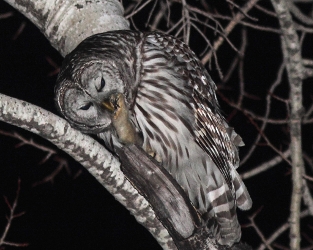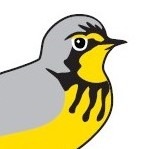By Kathy Jones, Ontario Programs Volunteer Coordinator, with contributions from Bird Studies Canada staff in each region

Barred Owl Photo: Christian Artuso
An early spring highlight for over 1200 adventurous Citizen Scientists is their annual Nocturnal Owl Survey, when they listen for and count owls along remote roads. These surveys are conducted in almost every province and territory, with an impressive network of coordinators and volunteers ensuring that the majority of southern Canada is monitored on an annual basis. The final product is a strong dataset with potential for national reporting on the status of owls in Canada. This valuable tool can be used to inform policymakers, guide sound conservation decisions, and enable Canada to meet its responsibilities with respect to conserving the world’s owl populations.
Please enjoy these regional highlights from the 2017 survey, achieved thanks to devoted volunteers like you.
Atlantic Canada
-
- For the first time, breeding was confirmed for Northern Saw-whet Owls on Newfoundland – an extension of their known breeding range! We’re working to expand the number of owl surveys on the island. Please get in touch with Travis Heckford (trheckford@mun.ca) if you’re interested in participating.
- The 2017 owl survey season in the Maritimes saw similar weather to the 2016 season, after the very late spring of 2015. We’re still finalizing the data, so be sure to check back for the next Atlantic Newsletter for the final analyses! Most routes in the Maritimes have already been assigned, but some remain available. Please contact Laura Tranquilla (ltranquilla@birdscanada.org) for more information.
Québec
- Despite extremely rainy conditions last season, participants returned data for 99 survey routes in Québec, detecting 350 owls of five species. This average of 3.7 owls per route is down from 4.6 in 2016, and below the long-term average of 3.9. There were notable decreases in the numbers of Barred and Northern Saw-whet owls detected compared with 2016, but Great Horned Owl numbers increased slightly. Typically, a decline in Barred and Northern Saw-whet owl numbers in the province has been followed by an increase. It will be interesting to see what happens this year, particularly given the high snowfalls, which can make hunting for prey more difficult.
- For information on the Québec Nocturnal Owl Survey or to participate, contact Andrew Coughlan (acoughlan@birdscanada.org).
Ontario
- The 23rd season of the Ontario Nocturnal Owl Survey was a complete success, with over 1400 stops surveyed across 196 routes in northern and central Ontario. Weather always plays havoc somewhere, but the participants and their assistants (friends, students, teachers, and family members) managed to collect valuable information on more than 900 owls. Keep an eye on the Ontario Nocturnal Owl Survey webpage for our 2018 newsletter.
- Ontario is looking for hardy individuals who would like to travel to northern Ontario for an April ‘owlcation.’ Check the Ontario Route Map to see the routes available, and contact Kathy Jones (volunteer@birdscanada.org) if you’re interested.
Manitoba
- 2017 was another productive year in Manitoba, with the program’s loyal volunteers having great success and enjoyment surveying their routes. Their efforts ensured that 105 routes were run in Manitoba. We are still inputting the data so stay tuned – the 2017 results will be shared with volunteers just before the 2018 season begins.
- For information on the Manitoba Nocturnal Owl Survey, contact Christian Artuso (cartuso@birdscanada.org).
Saskatchewan
- Bird Studies Canada and the Saskatchewan Breeding Bird Atlas team have recently been handed the torch to coordinate the Saskatchewan Nocturnal Owl Survey. We look forward to being an active part of this program, and building on the Saskatchewan owl survey network.
- Anyone interested in learning about this important monitoring program should contact LeeAnn Latremouille (skatlas@birdscanada.org).
British Columbia
- In 2017, 82 dedicated volunteers surveyed 72 routes, detecting 329 owls. The mean number of owls detected per 10 stops was 3.3, which is higher than the 2016 average of 2.7 and the long-term average of 2.0. Like most years, the most commonly detected species was the Northern Saw-whet Owl. Great Horned and Boreal owl detections were above average. Four routes were surveyed in June to detect Flammulated Owls, yielding seven detections.
- Contact Karen Devitt (kdevitt@birdscanada.org) for information on the British Columbia and Yukon Nocturnal Owl Survey.
Bird Studies Canada gratefully acknowledges all of the conservation partners who have supported the Nocturnal Owl Survey. We also thank the 2017 participants for their continued support, and wish the 2018 survey teams a wonderful season!
As with all long-term monitoring programs, there is an annual need to fill survey gaps. If you are interested in the Nocturnal Owl Survey, please contact the coordinator for your region through the program page on our website.

